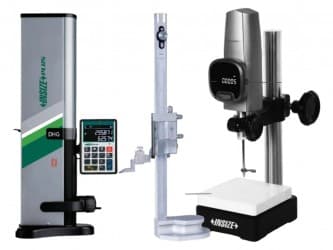Levels and Accessories
Featured Brands
Levels are measuring tools
used to determine the horizontal or vertical alignment of surfaces or objects.
They are commonly used in construction, carpentry, and various other
applications where accurate leveling is required. Here are some key types of
levels and accessories associated with them:
- Spirit Levels: Spirit levels, also
known as bubble levels, are the most common type of levels. They consist
of a sealed tube filled with liquid, usually alcohol or oil, and an air
bubble. The bubble moves within the tube when the level is placed on a
surface, indicating whether it is perfectly horizontal (level) or vertical
(plumb).
- Box Levels: Box levels are longer
and more rigid than spirit levels. They typically have multiple vials,
including horizontal and vertical vials, as well as 45-degree vials for
diagonal leveling. Box levels often have additional features such as
magnets or handles for convenient use.
- Laser Levels: Laser levels use
laser technology to project a visible or invisible laser beam onto
surfaces, providing precise leveling and alignment. They are particularly
useful for larger or outdoor projects, where a longer range is required.
Laser levels can be self-leveling or require manual adjustment.
- Torpedo Levels: Torpedo levels are
compact levels that are often small enough to fit in a tool belt or
pocket. They are commonly used for quick and accurate leveling in tight or
confined spaces. Torpedo levels usually have multiple vials, including
horizontal, vertical, and 45-degree vials.
- Digital Levels: Digital levels use
electronic sensors and a digital display to provide accurate leveling
measurements. They offer digital readouts of the angle or slope, making
them more precise and easier to read than traditional spirit levels.
Digital levels often have additional features such as data storage and
Bluetooth connectivity.
- Line Levels: Line levels are short
levels that are designed to check the straightness of horizontal lines.
They are commonly used in tasks such as hanging wallpaper or installing
tile. Line levels typically consist of a vial attached to a string or
line, allowing for precise alignment of horizontal surfaces.
- Level Accessories: Various
accessories can complement the use of levels, including:
- Leveling Tripods: Tripods are used
to securely position and stabilize laser levels for extended or elevated
measurements.
- Extension Poles: Extension poles
are used to increase the reach of laser levels when working on high or
distant surfaces.
- Leveling Rods: Leveling rods are
used in surveying or construction to measure vertical distances or
elevations accurately.
- Leveling Base: A leveling base is
a platform or mount that helps stabilize the level when working on uneven
surfaces.
- Protective Cases: Protective cases
or bags are used to transport and store levels, ensuring their safety and
longevity.
When choosing a level,
consider factors such as the required accuracy, length or size, and the
specific tasks or applications you will be using it for. It is also important
to maintain and calibrate levels regularly to ensure accurate and reliable
measurements.
.jpg&w=3840&q=75)
.jpg&w=640&q=75)
.jpg&w=640&q=75)
.jpg&w=640&q=75)
.jpg&w=640&q=75)




